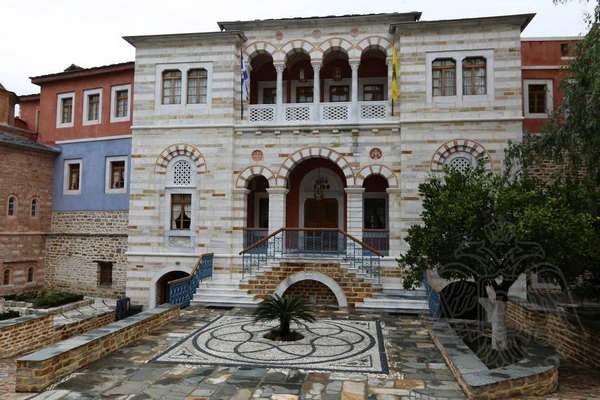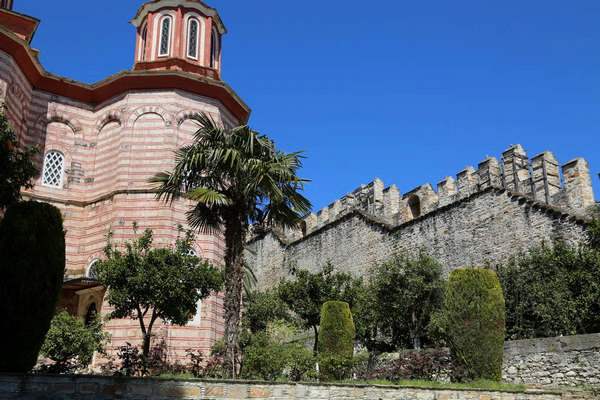History and present days

On the borders of Xenophontos Monastery there is a spring with holy water. The miraculous icon of Saint George arrived at this specific spot after travelling upright on the waves. The holy water immediately streamed from the earth to wash the holy relic. The icon now stands in the new katholikon of the monastery. The location of the spring is known as Xyna Nera (Sour Waters) or Xyno (Sour) and is visited by a great number of pilgrims, since the holy water is famous for its healing properties (especially in kidney diseases). The monks that visited this place to venerate the saint and drink some of the holy water were so many, that the community of the Xenophontos Monastery requested a patriarchal sigil that would prohibit the drinking of the water on site. However, there are testimonies that even until World War II one could see Russian monks using the holy water and washing themselves at the spring. Recently a small temple was built next to it. To the right there is a long sandy beach that stretches as far as the old monastery pier. A wall runs the entire length of the base of the courtyard. It holds back the ground and creates a terrace used as a vegetable garden.
While the Docheiariou Monastery is constricted due to the sloping terrain, the building complex of the Xenophontos Monastery is spread in the lowland formed by the torrent Nevrokopos. One would say that these two monasteries represent the two contrasting building models that are often repeated in the whole of Mount Athos.
The lowland location of the Xenophontos Monastery explains the need for a strong fortified wall that would ensure its defense against invaders. The bell tower and the domes of the new church, the largest existing in Mount Athos, project above the fortified wall. The monastery has two katholikos, the new and the old one. Another peculiarity is that its arsanas is not a separate complex, but rests integrated into the walls of the monastery. However, this was not necessarily a rare phenomenon. There can also be found other examples, such as the ruins of the arsanas of Saint Basil in the Hilandar Monastery, dating back to the 14th century, as well as the floor plan of a large arsanas that has recently come to light in the Monastery of Iviron. Apparently, the incorporation of the arsanas to the inside of the walls provided greater security in case of raids and sieges. Moreover, many auxiliary buildings (such as mills and stables) were also built into the fortress complexes of the monasteries during the Middle Ages. They were moved to the surrounding areas only when security conditions allowed it.
The incorporation of the arsanas has led to the transfer of the main entrance to its present location, as well as the creation of an intermediate gate. The new arsanas, whose pier is located to the right of the torrent, is currently in use. The plan of the monastery complex is heptagonal in shape. The sea-facing sides have wooden balconies. The high walls of the other wings keep their fortification character untouched. The original building core consists of the south wing with the old church, which is adjacent to the west wall. The extension of the monastery and the construction of the new katholikon date back to the 19th century, together with the west wing. The north-west corner was built in 1802 and housed the old archontariki. The south wing is parallel to the sea and was rebuilt after the fire of 1817 by the former Metropolitan of Samakovo, Philotheos, who settled in the monastery when he withdrew from his duties.
History
In early times, the Xenophontos Monastery was known as the "Monastery of Xenophos". According to one version, the name came from "Xyna Nera" (Sour Waters) and was related to the holy spring. However, according to tradition, the monastery was founded (circa 520) by Saint Xenophon, who is said to have built the temple of Saint Demetrius, close to the south side of the old katholikon. That second version is more accurate, since Saint Xenophon is also mentioned in the Life of Saint Athanasios the Athonite as the person who cured his brother at Mylopotamos. The year of the foundation of the monastery is considered to be 998. A document (1010) with the signature of the Saint is also preserved in the monastery. At that time, the miraculous icon of Saint George, thrown into the sea by the iconoclasts, arrived on the shore of the monastery. Saint Xenophon built the church of Saint George (the old church), cells and other necessary facilities to honor the miraculous relic. During the reign of Nikephoros III Botaneiates (1078-81) the monastery was completely deserted. Then came the great leader of the fleet Stephen, who undertook, together with his relatives and with the approval of the emperor, the reconstruction of the monastic structure. He also donated a great number of icons and manuscripts. He became a monk, received the name Simeon and was recognized as a new founder. A document of 1083 is referred to all those events. In the same document are also mentioned several monasteries of the surrounding areas, which were granted and incorporated into the monastery.
In 1285 the monastery was destroyed by a raid of Genoese pirates. In the 14th century it was also invaded by the Catalans but managed to recover. At the end of the 14th century, it occupied the 8th place in the hierarchy of the Athonite monasteries. The financial difficulties caused by the Ottoman occupation were overcome with the help of the rulers of Moldavia (1520). In 1726 the Russian traveler Barsky found the monastery in a poor state, with only 3-4 monks.
After being an idiorrhythmic community for a great period of time, Xenophontos Monastery was the first to revert to the cenobitic system (1784), with the approval of the Ecumenical Patriarch Gabriel IV. The monastery remained cenobitic ever since. Its first abbot became the Kausokalyvite monk Paisios, who renovated and expanded it with the help of the sacristan Constantine and the archimandrite Zacharias. The restoration of the monastery after the catastrophic fire of 1817 begun by Philotheos, whose work was continued by the Abbot Nikephoros from Evia.
Today, a great number of monks live in Xenophontos Monastery. A part of them had also moved to the Pantokratoros Monastery in 1992 in order to fill its community. The magnificent celebration of its millennium (1998) is a historical milestone in the recent history of the Athonite State. When 35 years earlier the anniversary of the millennium of Mount Athos was celebrated (from the foundation of the Monastery of Great Lavra), many people, seeing the abandonment and desolation, considered that the celebration was at the same time the end of the Athonite monasticism. However, shortly afterwards there was noticed a general recovery, which led to the filling of the monasteries with new brotherhoods and their return to the cenobitic system. The celebration of the millennium of the Xenophontos Monastery, in the presence of the Ecumenical Patriarch, the Archbishop of Athens, the President of the Republic, ministers and other great personalities of the state, sealed this recovery and presented an active monastic state, whose appeal to the outside world is at a higher level than ever before.
In the Xenophontos Monastery, the holy young martyr Akakios († 1815, Constantinople) had lived for several years.


 (Одигитрия).jpg)






